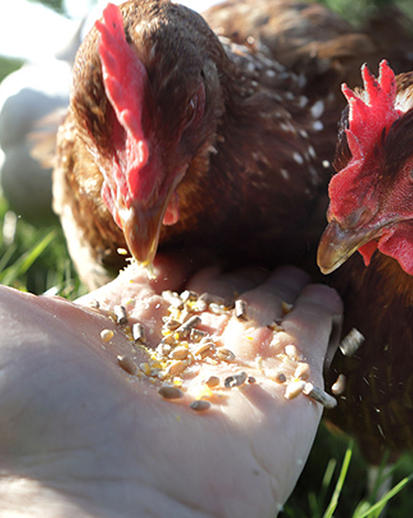Focus domains
With our unique science-based competences, we have created a strong platform for growth and are ideally positioned to capture the growth opportunities offered by the global megatrends and Sustainable Development Goals (SDGs). In particular, we focus on developing innovative solutions centered on Nutrition & Health, Climate & Energy, and Resources & Circularity.
Nutrition & Health
The link between adequate nutrition and health has never been clearer. Diet-related non-communicable diseases (including diabetes, heart disease, stroke, and some cancers) have overtaken communicable diseases as the primary cause of deaths worldwide. At the same time, malnutrition in its various forms affects more than 30% of the world’s population: more than 2.3 billion adults and children are obese or overweight1, more than 820 million people go to bed hungry each night, and approximately two billion suffer from hidden hunger2.
With the world’s growing and ageing population, the costs of healthcare systems as we know them today are becoming increasingly unsustainable for developed and developing countries alike.
Furthermore, the animal protein industry, which produces the animal-source foods critical for a healthy and balanced diet, is increasingly challenged to reduce its impact on the environment and to improve animal welfare, while at the same time driving down production costs.
Individuals and societies need solutions that offer preventive and sustainable ‘health through nutrition’, as well as solutions that enable the creation of an animal protein supply that can feed the world within planetary boundaries.
The COVID-19 health crisis throws all of these needs into yet sharper focus.
Climate & Energy
The stability of the world’s climate is under threat. We have long believed there is an urgent need to take action to curb climate change and its irreversibly damaging effects by significantly limiting greenhouse gas emissions, transitioning to renewable energy, and adopting low-carbon emission solutions and processes. Partly as a result of the pandemic crisis in 2020, there is also an increasing realization that food systems and the climate crisis are intimately intertwined. Not only are food systems responsible for approximately a quarter of all global emissions3, it is also the sector of the economy that will be affected the quickest everywhere. We are seeing already today the catastrophic impact of climate change on food production in many countries, leading to increased hunger and social instability, and this will only increase. Yet many innovations exist that can meaningfully reduce the climate impact of food production, and these need to be scaled in an equitable way for both the farmers and consumers.
The transition to a low-carbon economy will also create business opportunities and drive growth for our innovative and sustainable solutions. We are enabling the development of a low-carbon economy not just by reducing our own emissions but also by developing solutions to help customers and consumers to cut theirs.
Resources & Circularity
The world’s resources are finite, and with a population projected to grow to 9.7 billion people by 20504, some estimates suggest we will need the equivalent of four Planet Earths by then to sustain our current lifestyles. In addition, over 30% of all food produced is currently either lost or wasted, representing a huge drain on natural resources5. New ways of achieving a balance between demand and supply have to be found, including approaches that are not based on single use and subsequent disposal. We are making important contributions to the development of a genuinely circular, bio-based economy founded on closed-loop solutions.
1 Source: IFPRI
2 Source: FAO
3 Source: IPCC report 2019
4 Source: UN
5 Source: Good Nutrition: Perspectives for the 21st Century. Eggersdorfer M. et al. Karger, Basel 2016
Primary energy is energy that has not yet been subjected to a human engineered conversion process. It is the energy contained in unprocessed fuels.
Final (consumed) energy is the energy that is consumed by end-users. The difference between primary energy and final consumed energy is caused by the conversion process between the two as well as any transmission losses.
Scope 1: Direct GHG emissions
Direct GHG emissions occur from sources that are owned or controlled by the company (i.e., emissions from combustion in owned or controlled boilers, furnaces, vehicles, etc.).
Scope 2: Indirect GHG emissions
Indirect GHG emissions relate to the generation of purchased energy (i.e., electricity, heat or cooling) consumed by the company. Purchased energy is defined as energy that is purchased or otherwise brought into the organizational boundary of the company. Scope 2 emissions physically occur at the facility where the energy is generated.
Scope 3: Value chain emissions
Scope 3 emissions are all indirect emissions (not included in scope 2) that occur in the value chain of the reporting company, including both upstream and downstream emissions.
Location-based emissions
Reflects the average GHG emissions intensity of grids on which electricity consumption occurs (using mostly national grid-average emission factor data). Corresponding emission factor: in most cases, the country emission factor.
Market-based emissions
Reflects GHG emissions from electricity supplies that companies have purposely chosen (or their lack of choice) and contracted. Corresponding emission factors:
- Supplier specific emission factor (provided by the supplier)
- Residual emission factor (country-based grid factor, corrected for allocated purchased electricity from renewable resources)







